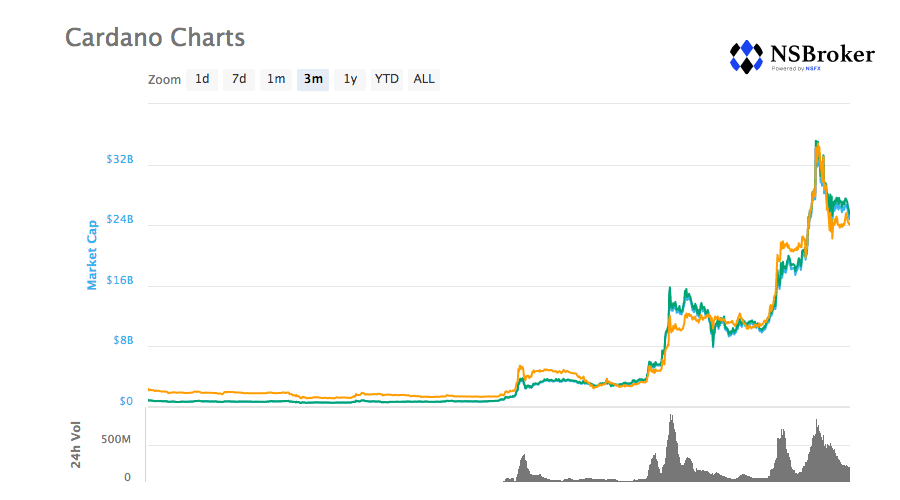What Is Cardano and How This Platform Works

The emergence of blockchain technology as a means for the distribution of cryptocurrencies has opened the door to many activities lined with its application. Many platforms focus their functions on blockchain-related areas of operation. One of them is Cardano, which will be discussed in this article in detail.
Cardano: What Is It?
Cardano is a blockchain platform that, in many respects, shares numerous characteristics with other platforms of this type while being different in no fewer respects. It belongs to the third generation of blockchain platforms, which increases its efficiency and reliability. Also, Cardano relies on a proof-of-stake paradigm. One of the most fundamental differences that distinguish Cardano from other blockchain platforms is the significant focus on research and theoretical developments that the platform actively uses to evolve and improve. Thus, it is possible to claim that Cardano is one of the few blockchain platforms that operate on an academic basis.
Cardano was founded by a collective effort, with at least three companies involved in its creation. These were the Cardano Foundation, IOHK, and EMURGO. The latter is the only organization on the list that operates on a profitable basis. In turn, the first two are non-profit entities. They are directly involved in the development of the Cardano platform and conducting research (as well as implementing the existing studies) for the sake of the system's development.
Cardano: The Essentials
Like most other elements of the cryptocurrency ecosystem operating in the modern world, Cardano is closely linked to some other platforms and systems. Thus, the platform, launched in 2017, was developed by the co-founder of the Ethereum platform, Charles Hoskinson. Because of this fact, there are numerous similarities between the two platforms under discussion. Both Ethereum and Cardano are characterized by a number of identical features. In the most general terms, they are decentralized systems based on smart contracts. At the same time, as is often the case with blockchain platforms, Cardano, which emerged a few years after Ethereum, is positioned as an improved, developed, and refined alternative to its predecessor, designed with the latter's shortcomings and weaknesses in mind.
One of the central goals that Cardano declares for itself is to provide banking services to all categories of the population who do not have access to conventional banking platforms in the areas of their habitat. Also, some of the central spheres in which the platform conducts its research and development activities are traceability and identity management. The first mentioned aspect concerns the tracking of manufacturing processes in order to eliminate counterfeit products. The second aspect focuses on data collection. Thus, the company's activities are diverse and heterogeneous.

Cardano Products
Given the central areas in which it operates, Cardano has several key products on its track record. The first is Atala PRISM. It is a specific digital tool used to verify people's identities. For example, it can be used in a situation where a person wants to conduct some operations with a bank account, for which confirmation of his or her identity is required. The second project is Atala SCAN. Cardano's third project is known as Atala Trace. They both operate in the same field, being used to track the life cycles of certain products. In addition, Cardano also focuses its efforts on developing some projects that will be used to design software in the future. For example, one of the products the company is currently working on is a platform that can be utilized by third parties to develop decentralized programs.
Cardano Functioning Algorithms
All blockchain systems operate on the basis of certain algorithms. In the case of Kandano, the algorithm being used is known as Ouroboros. It has blocks based on the PoS protocol. Thanks to this specific protocol, the platform manages to reduce energy consumption to the lowest possible levels, which has a positive effect on the sustainability of the platform, especially compared to Bitcoin, which operates based on a much more energy-intensive PoW protocol.
Ouroboros, Cardano's main functional algorithm, works in a highly specific manner. It takes into consideration the physical time that the operations take and subsequently divides it into conditional "epochs" (at the moment, one epoch is equal to five days). Then, the epochs are split into slots, each denoting a particular time period (currently, one slot is approximately one second long). The actual size of epochs and slots is not constant, usually being reviewed after each update of the platform.
The slots have their leaders who are selected based on a specific "lottery" pattern. The leader's chances of winning the "lottery" depend on their stakes. Leaders perform such tasks as transaction validation, generating new transaction blocks, and adding those blocks to the blockchain. When using Ouroboros, it is not necessary for a large number of holders to be available online. A satisfactory network functioning can be maintained by a relatively small number of subjects. Besides, to minimize energy usage, the holders create stake pools. Only a few representatives of these pools are required to participate in protocol execution. In such a way, the creation of blocks can be maintained even if not all holders are available online.
Mining on Cardano
The mining system on the Cardano platform differs significantly from that typical for platforms operating based on the PoW protocol. In the latters' case, miners receive a reward from transaction fees and cryptocurrency shares. In turn, Ouroboros distributes the awards received from each era between stakeholders and steak pools. The bigger each holder's steak, the higher their reward. Thus, Cardano encourages the proportional participation of holders in its operation, providing a reward to everyone based on their contributions and efforts, which qualitatively sets it apart from other blockchain platforms.









